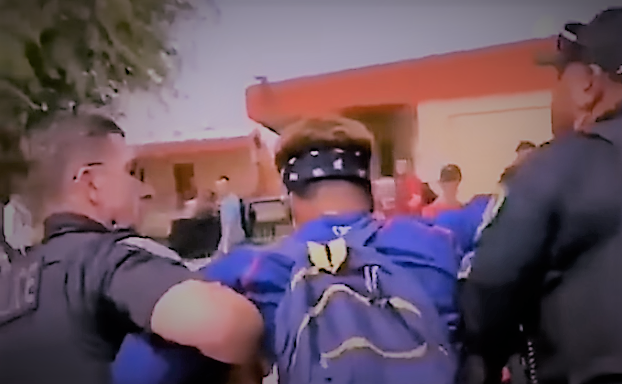
It’s no secret that our country incarcerates people of color at much higher rates than white people. What might be less well known is that this can begin in the classroom.
Across the country, schools routinely punish, suspend, and expel students of color at higher rates than white students — setbacks that can follow students for years. Those were the findings of a new Institute for Policy Studies report called Students Under Siege.
I saw this firsthand going to school in Indiana. A report by the Indiana Advisory Committee to the U.S. Commission on Civil Rights found that Indiana “ranks second in the country in its rate of black male out-of-school suspensions” and “ranks fourth in the rate of black female out-of-school suspensions.”
It’s not an issue of one group “misbehaving” more than another. An Indiana University study found that black and Latino students are suspended for much more subjective reasons than their white peers. For instance, a white student might be suspended for smoking, while a black, Latino, or Latina student might be suspended for the much murkier offense of being “disruptive.”
I watched the same pattern play out at William Henry Harrison, the West Lafayette, Indiana high school I graduated from in 2015. Despite students of color making up less than a quarter of its student body, they’re overrepresented in suspension rates.
In 2015, 20 percent of black students, 12.3 percent of Latino and Latina students, and 10.5 percent of students identifying with two or more races received in-school suspensions. Numbers were similar for out-of-school suspensions, and rose considerably for students who were expelled: Half were Latino and a quarter were black.
What can schools do to combat these suspensions rates? Portage High School in Northwest Indiana offers an example of the positive effects restorative justice can have on students.
Restorative justice, a government report from neighboring Illinois explains, is “a philosophy based on a set of principles that guide the response to conflict and harm,” influenced by indigenous and religious practices. Instead of punishing students, restorative justice hopes to empower students to fully understand why they act the way they do, and take steps to heal any harms they cause.
Jackson, a Portage student whose story was reported in the Northwest Indiana Times, was deemed a “troublemaker” in middle school. He was written up almost 200 times when he was a seventh grader and expelled the following year. He acted this way, he later said, because he’d just moved from Chicago and didn’t feel like the other students respected him.
At Portage, Jackson was introduced to restorative justice by Sandra Porter-Philips, a social and emotional learning specialist who also manages the school’s Teen Court. He’s participated in the school’s restorative justice circle for the past two years.
The circle has given him an “outlet to relieve my anger” in a healthy way, he said. He’s now passing all his classes and participating in multiple school sports.
Fortunately, interest in restorative justice seems to be growing. The Indiana House recently passed a bill that aims to decrease suspension rates. If the bill passes the state Senate, Indiana’s Department of Education would create an “evidence-based plan” that focuses on “positive discipline strategies and restorative practices.” The plan would go into effect sometime in the next two years.
Restorative justice is moving forward in districts all over the country — from Washington, DC to Oakland, California. And I hope the idea keeps spreading here in Indiana — and maybe even to my old school, Harrison.
We’re not backing down in the face of Trump’s threats.
As Donald Trump is inaugurated a second time, independent media organizations are faced with urgent mandates: Tell the truth more loudly than ever before. Do that work even as our standard modes of distribution (such as social media platforms) are being manipulated and curtailed by forces of fascist repression and ruthless capitalism. Do that work even as journalism and journalists face targeted attacks, including from the government itself. And do that work in community, never forgetting that we’re not shouting into a faceless void – we’re reaching out to real people amid a life-threatening political climate.
Our task is formidable, and it requires us to ground ourselves in our principles, remind ourselves of our utility, dig in and commit.
As a dizzying number of corporate news organizations – either through need or greed – rush to implement new ways to further monetize their content, and others acquiesce to Trump’s wishes, now is a time for movement media-makers to double down on community-first models.
At Truthout, we are reaffirming our commitments on this front: We won’t run ads or have a paywall because we believe that everyone should have access to information, and that access should exist without barriers and free of distractions from craven corporate interests. We recognize the implications for democracy when information-seekers click a link only to find the article trapped behind a paywall or buried on a page with dozens of invasive ads. The laws of capitalism dictate an unending increase in monetization, and much of the media simply follows those laws. Truthout and many of our peers are dedicating ourselves to following other paths – a commitment which feels vital in a moment when corporations are evermore overtly embedded in government.
Over 80 percent of Truthout‘s funding comes from small individual donations from our community of readers, and the remaining 20 percent comes from a handful of social justice-oriented foundations. Over a third of our total budget is supported by recurring monthly donors, many of whom give because they want to help us keep Truthout barrier-free for everyone.
You can help by giving today. Whether you can make a small monthly donation or a larger gift, Truthout only works with your support.